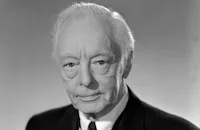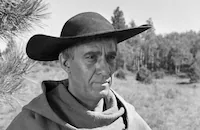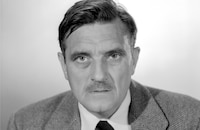Adventure

Brief Synopsis
Cast & Crew
Victor Fleming
Clark Gable
Greer Garson
Joan Blondell
Thomas Mitchell
Tom Tully
Film Details
Technical Specs

Synopsis
When his ship is torpedoed by a Japanese submarine, Harry Patterson, a handsome, rough-and-ready World War II merchant marine boatswain, is cast adrift on a launch with a few of his shipmates. Harry remains calm in the face of disaster, but his friend Mudgin panics and makes desperate pleas to God for help, promising to avoid women, liquor and fighting and to donate money to the church if they are saved. Harry finds Mudgin's pleas ridiculous, but no sooner does Mudgin complete his pact with God than a rescue plane appears on the horizon and the men are saved. The seamen are deposited in San Francisco, where they celebrate their safe return to land with a haircut and a visit to a bar. Mudgin breaks all his promises to God soon after arriving in San Francisco and becomes depressed, certain that he has "lost his immortal soul." While Mudgin's shipmates laugh off his concerns, Harry, realizing that Mudgin is truly wracked with guilt, helps his troubled shipmate find his lost soul. Their journey takes them no further than a city library, where Harry and Mudgin meet the attractive, straight-laced librarian Emily Sears. Although intrigued by Emily, Harry repeatedly raises her ire with his brutish manner and argumentative nature. Harry's attention quickly shifts away from Emily, however, when her outgoing roommate, Helen Melohn, arrives. Harry and Helen hit it off immediately, and Emily reluctantly accompanies the three on a dinner date. At the restaurant, Emily stuns Harry when she abandons her reserved demeanor and starts a bar fight to bring the night to a close. Convinced that Emily is the "freshest dame" he ever met, Harry decides to pursue her affections in earnest and arranges to meet the two women the following day at Emily's farm outside the city. Harry and Emily soon fall completely, though contentiously, in love and get married in Reno. When they return to Emily's farm, Harry tells Emily that he will be shipping out in a few days, which comes as a shock to Emily and prompts her to ask for a divorce. Harry sails for the high seas, and during his absence Emily realizes that she is pregnant with Harry's child. While docked in a South American port city, Mudgin falls off the ship and, before dying in Harry's arms, says that his soul has been returned to him. Months after his departure, Harry returns to San Francisco and learns from Helen that Emily has long since given up on him and gone to her farm to give birth to their child. Harry arrives at the farm just as Emily goes into labor, and when the baby is stillborn, he repeatedly slaps the baby until it begins to breathe. Afterward, Harry and Emily share a tender kiss.

Director

Victor Fleming
Cast

Clark Gable

Greer Garson

Joan Blondell

Thomas Mitchell

Tom Tully

John Qualen

Richard Haydn

Lina Romay

Philip Merivale

Harry Davenport
Tito Renaldo
Pedro De Cordoba
Chef Joseph Milani

Martin Garralaga
Jack Young
Dorothy Granger
Gladden James
Ray H. Mckay
Al Masiello
Billy Newell
Esther Howard
Florence Auer
Harry Wilson
Myron Geiger

Lee Phelps
George Suzanne
Eddie Hart
Richard Abbott
Fred Hoose
Major Farrell
Frank Pharr
Joe Kamaryt
Aileen Carlyle
Jack Sterling
Paul Stader
Frank Hagney
Betty Blythe

Pierre Watkin
Charles Latorre
Dorothy Vaughan

Morris Ankrum
Johnny Berkes
John Harmon
Charles Sherlock
James Darrell
Garry Owen
Ralph Peters

Joseph Crehan

Ray Teal

Byron Foulger

Audrey Totter
Marta Linden
June Terry Pickerell
Marjorie Wood
Harry Tyler

Bess Flowers
Joan Thorsen
Stanley Andrews

Kay Medford

Rex Ingram

Tim Murdock
Walter Knox
Jack Kenny

Max Davidson
Bill Beauman
Alex Palasthy
Pete Sosso
John Piffle
Charles Millsfield
Alex Novinsky
Charles Meakin
William Wagner
D'arcy Corrigan
Count Stefenelli
Fred Fox
Eric Mayne
Harry Denny
Gene Leslie
William Mussetter
Carli Elinor
Blanche Rose
Margaret Millsfield
Genevieve Bell
Vangie Beilby

Claire Mcdowell
Charles Haefl
Jeffrey Sayre
Ed Randolph
Charles Regan
Tom Kingston
Sayre Dearing
Nina Bara
Zedra Conde
Toni Larue
Kanza Omar
Augie Gomez
Roque Ybarra
Paul Smith
Miguel Contreras
George Derrick
Charles Stevens
Robert E. O'connor
Hercules Mendez
George Peters
Cliff Powell
Clay Anderson
Jon Gilbreath
Franco Corsaro
Lita Cortez
Helen Mcleod
Connie Montoya

Elizabeth Russell
Barbara Billingsley
Rebel Randall
Sue Moore
Martha Wentworth
Dick Elliott
Ila Lee
Barbara Combs
Martha Bamattre
Crew
Edward Baravalle
Frederick Hazlitt Brennan
Frederick Hazlitt Brennan
Murray Cutter
Mark Davis
Jack Dawn
James Z. Flaster
Victor Fleming
Perez Freire
Cedric Gibbons
A. Arnold Gillespie
Sydney Guilaroff
Irene
Marion Herwood Keyes
Standish J. Lambert
Vincent Lawrence
M. J. Maclaughlin
Robert Martin
Urie Mccleary
Warren Newcombe
Ralph A. Pender
George Richelavie
Joseph Ruttenberg
Douglas Shearer
Robert W. Shirley
Newell Sparks
William Steinkamp
Michael Steinore
Herbert Stothart
Herbert Stothart
Walter Strohm
Marvin Stuart
Frank Sullivan
Anthony Veiller
Charles E. Wallace
Bea Whitney
John A. Williams
Edwin B. Willis
William H. Wright
Sam Zimbalist

Videos
Movie Clip



Trailer
Hosted Intro
Film Details
Technical Specs

Articles
Adventure
Although MGM pushed hard to get a deferment, Gable went into the Army Air Corps in August of 1942, his chief motivation widely believed to be in honor of Carole Lombard, his wife of only three years, who died in a plane crash in January that year - she was on tour selling war bonds. The Gable that returned had aged from not only the personal tragedy, but also the devastation of war-although he saw very little action firsthand. The property lined up as his comeback vehicle was Adventure, a dramatic romance about a lustful seaman who ultimately finds love and stability with a librarian. It was only fitting that "The King" should have a queen; Greer Garson, at the pinnacle of her career, was cast as the female lead. In 1943, Garson won the Best Actress Oscar® for her role in Mrs. MiniverGone with the Wind (1939). Gable vowed to not act as long as fighting in Europe continued, so production started thirteen days after Victory-in-Europe Day.
The film was based on This Strange Adventure, a novel by Clyde Brion Davis. Although four writers had worked on the screenplay, Fleming was still dissatisfied with the result. He called on oft-collaborator John Lee Mahin to jump in. Mahin did, despite the fact that he was still in the Air Force. He worked in secret and ultimately without a screen credit. Initially, the production was pleasant enough: Greer affectionately nicknamed Fleming "Mr. Vic," and Gable struck up a fast friendship with supporting actress Joan Blondell. Things, however, quickly turned sour; in the biography Clark Gable by Warren G. Harris, MGM publicist Emily Torchia recalls, "Gable and Garson never hit it off. He'd look at her as if she wasn't even there . . . with warm, earthy girls like Jean Harlow and Lana Turner, he was his usual charming self. With others he could be as cold as ice." Blondell was one such earthy girl; prim, British Garson was not. One idiosyncrasy of Garson's infuriated Gable; she insisted upon the placement of screens around the actors during romantic scenes to maintain privacy. She explained in A Rose for Mrs. Miniver: The Life of Greer Garson: "Playing a love scene requires a feeling of intimacy between man and woman and intense concentration. I don't like to look over the shoulder of a man and see the long gloomy sound stage behind the camera, cluttered with equipment and pieces of sets from past pictures." Lina Romay, a bit player in the film, sums up Gable's perspective best with her observation that, "They were opposites. She'd insist on velvet slats around them when they acted. . . whereas Gable was a big, open guy who liked to use four-letter words."
Gable also liked to drink; his alcoholism only worsened after Lombard's death and the resulting added weight was becoming a problem on film. He countered it by taking Dexedrine, an appetite suppressant, but the medicine caused excessive perspiration and "the shakes." Fleming, ever patient, called a stop to the action whenever Gable had an episode. Blondell gained some insight into Gable's mindset when he invited her over to the house for dinner during production. In the Gable biography Long Live the King by Lyn Tornabene, she recalls, "He had Carole's room just the way she left it, but said someday he would change it. . . he had bought every picture Carole ever made, and looked at them, often. He spent a lot of lonely hours at that house." Not every memory, though, was so desperate. At other times she remembered him as jovial: "He'd go get us some steaks, make them himself, and eat with us in the kitchen wearing a towel apron."
Even though the film wrapped in July of 1946, MGM's publicity teams had already been in promotion overdrive for several months. Plastered in magazines, billboards, and featured in radio spots, the film teaser crowed, "Gable's back and Garson's got him!" It was even painted in giant letters on the Loew's Building in Times Square. For once, the two actually had something in common - they hated the ad campaign. Garson decreed it "ungallant", while the Tornabene bio explains, "Clark hated being called 'Gable,' hated being got by Garson, hated the repetition of the slogan." The 1946 premiere at Radio City Music Hall was indicative of the high hopes the studio had for the film, and indeed, Adventure did break all box office records in its first week there. But mixed reviews and rapidly declining audiences quickly put a damper on its opening success. Adventure eventually grossed a respectable half a million in profit, and while not doing Gable's career much harm, the damage to Garson's was severe. The slogan at least provided a last laugh, inspiring that year's Oscars® host Bob Hope to joke about Gable's next project being with a star of another kind: "Clark's bark makes Lassie sassy!"
Producer: Sam Zimbalist
Director: Victor Fleming
Screenplay: Frederick Hazlitt Brennan, Vincent Lawrence, Anthony Veiller, William H. Wright, Clyde Brion Davis (novel)
Cinematography: Joseph Ruttenberg
Film Editing: Frank Sullivan
Art Direction: Cedric Gibbons, Urie McCleary
Music: Herbert Stothart
Cast: Clark Gable (Harry Patterson), Greer Garson (Emily Sears), Joan Blondell (Helen Melohn), Thomas Mitchell (Mudgin), Tom Tully (Gus), John Qualen (Model T).
BW-126m. Closed captioning.
by Eleanor Quin

Adventure
Quotes
Trivia
Notes
Working titles for this film were The Big Shore Leave, Strange Adventure and This Strange Adventure. The picture marked Clark Gable's first film since his return from serving three years in the Army Air Corps. A September 3, 1941 Hollywood Reporter news item indicates that Spencer Tracy was originally set for the part played by Gable. The same news item noted that production was set to begin the following day. According to a February 1946 article in New York Times, actress Greer Garson, commenting on the publicity line associated with the film, "Gable's Back, and Garson's Got Him," reportedly said: "Well, just as long as they didn't say Garson's back, and who wants her!"
Although Hollywood Reporter production charts list actor Larry Burke in the cast, his appearance in the released film has not been confirmed. A May 1945 article in Los Angeles Daily News notes that the film's set of the San Francisco public library was remodelled from the set used for the Waldorf Astoria hotel lobby in the film Weekend at the Waldorf (see below). Lina Romay was formerly a featured singer with Xavier Cugat's band. Adventure marked the feature film debut of actress Barbara Billingsley, who became best known for her role as "June Cleaver" on the popular television series Leave It to Beaver.

Miscellaneous Notes
Released in United States 1945
Released in United States 1945















